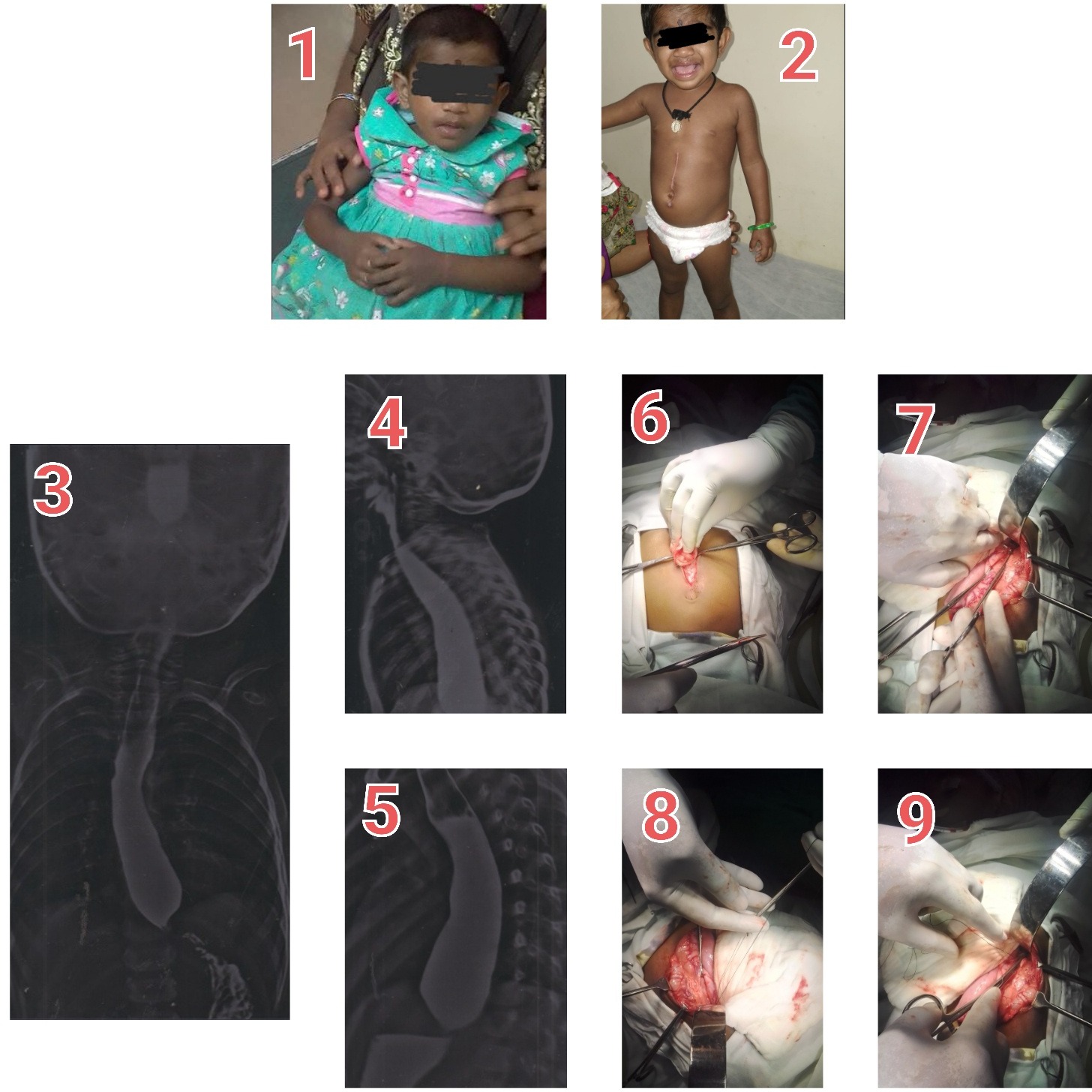Back
Poster Session A - Sunday Afternoon
A0609 - Achalasia Cardia in Child With Severe Malnutrition: A Case Report
Sunday, October 23, 2022
5:00 PM – 7:00 PM ET
Location: Crown Ballroom
.jpg)
Chetana Pasam, MBBS
Apollo Hospital
Kakinada, Andhra Pradesh, India
Presenting Author(s)
Chetana Pasam, MBBS1, Tejaswi Pasam, MBBS2, Richa Mudwari, MBBS3, Jahnavi Raparti, MBBS4
1Apollo Hospital, Kakinada, Andhra Pradesh, India; 2Patient First Medical Center, Dearborn, MI; 3North Sichuan Medical College, Gaithersburg, MD; 4Kamineni Academy of Medical Sciences and Research Centre, Hyderabad, Telangana, India
Introduction: Achalasia cardia is an esophageal motility disorder due to the failure of the lower esophageal sphincter to relax. It is extremely rare in the pediatric population with an incidence of 0.11 per 100,000 children. In children, it is usually associated with other conditions like Adrenal glucocorticoid deficiency and Down’s syndrome. The symptoms include vomiting, regurgitation, and weight loss. Its exact etiology is still unclear. It is considered to be due to degeneration of the myenteric plexus that innervates the lower esophageal sphincter leading to difficulty with swallowing and absence of peristalsis.
Case Description/Methods: We present the case of a 3-year-old girl with a history of recurrent vomiting and poor weight gain. Her symptoms have been progressive for over 2 years. The child was initially treated at multiple local hospitals for Gastroesophageal reflux disease with no improvement. At presentation, she was severely malnourished and weighed 6 kgs. On evaluation, she was also found to be anemic. After admission to our pediatric unit, she underwent a barium study which showed tapering of the distal esophagus, representing the classic bird-beak sign, and the diagnosis of achalasia cardia was confirmed. She was treated surgically by Heller’s Cardiomyotomy and Fundal Wrap. Her post-operative phase was uneventful and she was discharged with follow-up advice. She exhibited excellent recovery with good weight gain and resolution of her symptoms. Her weight at the 1-month follow-up visit was 9kgs and at 3 months it was 12kgs.
Discussion: Achalasia cardia is a rare presentation in children but can lead to major health concerns if left untreated. Due to the nonspecific symptoms, it is mostly misdiagnosed as gastroesophageal reflux disease which leads to delayed diagnosis and severe malnutrition. Diagnosis is with barium swallow study and manometry. It is followed by endoscopic biopsy in adults to rule out malignancy, however, it is not a consideration in children. Medical management has often shown recurrence of symptoms, particularly in children, and is not considered an effective choice of treatment. Surgery is the definitive treatment and includes Heller’s esophagomyotomy with or without anti-reflux procedures. Prompt diagnosis and treatment have an excellent prognosis. Peroral endoscopic myotomy is a promising new therapy in adults with achalasia but has limited studies in children. Persistent undiagnosed cases can lead to severe malnutrition and failure to thrive.

Disclosures:
Chetana Pasam, MBBS1, Tejaswi Pasam, MBBS2, Richa Mudwari, MBBS3, Jahnavi Raparti, MBBS4. A0609 - Achalasia Cardia in Child With Severe Malnutrition: A Case Report, ACG 2022 Annual Scientific Meeting Abstracts. Charlotte, NC: American College of Gastroenterology.
1Apollo Hospital, Kakinada, Andhra Pradesh, India; 2Patient First Medical Center, Dearborn, MI; 3North Sichuan Medical College, Gaithersburg, MD; 4Kamineni Academy of Medical Sciences and Research Centre, Hyderabad, Telangana, India
Introduction: Achalasia cardia is an esophageal motility disorder due to the failure of the lower esophageal sphincter to relax. It is extremely rare in the pediatric population with an incidence of 0.11 per 100,000 children. In children, it is usually associated with other conditions like Adrenal glucocorticoid deficiency and Down’s syndrome. The symptoms include vomiting, regurgitation, and weight loss. Its exact etiology is still unclear. It is considered to be due to degeneration of the myenteric plexus that innervates the lower esophageal sphincter leading to difficulty with swallowing and absence of peristalsis.
Case Description/Methods: We present the case of a 3-year-old girl with a history of recurrent vomiting and poor weight gain. Her symptoms have been progressive for over 2 years. The child was initially treated at multiple local hospitals for Gastroesophageal reflux disease with no improvement. At presentation, she was severely malnourished and weighed 6 kgs. On evaluation, she was also found to be anemic. After admission to our pediatric unit, she underwent a barium study which showed tapering of the distal esophagus, representing the classic bird-beak sign, and the diagnosis of achalasia cardia was confirmed. She was treated surgically by Heller’s Cardiomyotomy and Fundal Wrap. Her post-operative phase was uneventful and she was discharged with follow-up advice. She exhibited excellent recovery with good weight gain and resolution of her symptoms. Her weight at the 1-month follow-up visit was 9kgs and at 3 months it was 12kgs.
Discussion: Achalasia cardia is a rare presentation in children but can lead to major health concerns if left untreated. Due to the nonspecific symptoms, it is mostly misdiagnosed as gastroesophageal reflux disease which leads to delayed diagnosis and severe malnutrition. Diagnosis is with barium swallow study and manometry. It is followed by endoscopic biopsy in adults to rule out malignancy, however, it is not a consideration in children. Medical management has often shown recurrence of symptoms, particularly in children, and is not considered an effective choice of treatment. Surgery is the definitive treatment and includes Heller’s esophagomyotomy with or without anti-reflux procedures. Prompt diagnosis and treatment have an excellent prognosis. Peroral endoscopic myotomy is a promising new therapy in adults with achalasia but has limited studies in children. Persistent undiagnosed cases can lead to severe malnutrition and failure to thrive.

Figure: Fig1:At presentation, weight 6kgs; Fig2:At 3months, weight 12kgs; Fig.3,4,5: Barium Study; Fig6: Supraumbilical midline incision; Fig7:Cardiomyotomy; Fig8:Approximation of Crura; Fig9:Fundal Wrap
Disclosures:
Chetana Pasam indicated no relevant financial relationships.
Tejaswi Pasam indicated no relevant financial relationships.
Richa Mudwari indicated no relevant financial relationships.
Jahnavi Raparti indicated no relevant financial relationships.
Chetana Pasam, MBBS1, Tejaswi Pasam, MBBS2, Richa Mudwari, MBBS3, Jahnavi Raparti, MBBS4. A0609 - Achalasia Cardia in Child With Severe Malnutrition: A Case Report, ACG 2022 Annual Scientific Meeting Abstracts. Charlotte, NC: American College of Gastroenterology.
